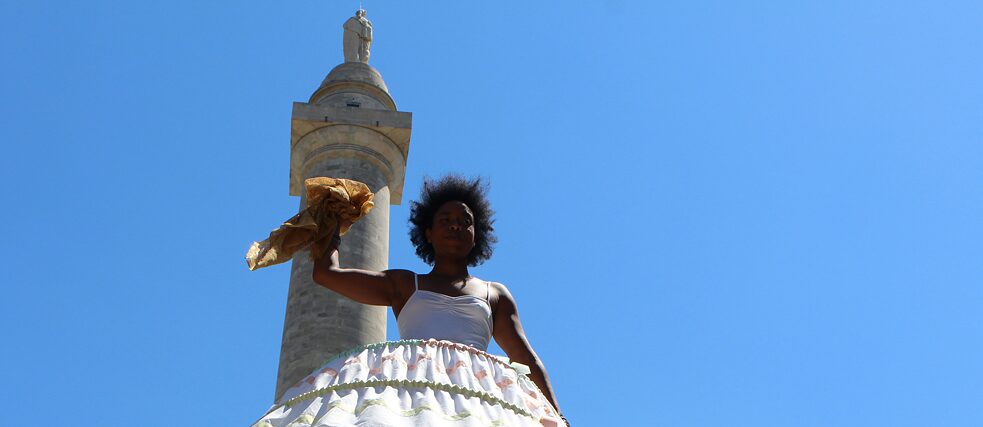Shaping the Past
Wavering Monuments

How do monuments shape the commemorative culture? How can they become places of participation? The project “Shaping the Past” of the Goethe-Institut, the Monument Lab and the Federal Agency for Civic Education brings together initiatives from North America and Germany.
By Paul M. Farber
On the night of May 31, 2020, in Birmingham, Alabama, a crowd gathered in the city’s Linn Park to protest the murder of George Floyd and systemic racism. Surrounded by municipal buildings including City Hall and the Jefferson County Courthouse, a group attempted to tear down an over hundred-year old commemorative obelisk, the Confederate Soldiers and Sailors Monument.
Installed in 1905, the monument was supported by the United Daughters of the Confederacy, a civic organization founded to enshrine the “Lost Cause” of the defeated Southern States in the Civil War while romanticizing and whitewashing the institution of slavery. The Confederate Soldiers and Sailors Monument was one of dozens of statues they helped dedicate across the United States, amidst other widespread commemorative campaigns, that together re-inscribed everyday forms of racism into public spaces.
Flashpoints of a Long-awaited Reckoning
That evening in May, people in Birmingham first broke apart the box that had blocked the memorial from view, spray painted the base, and began a takedown with ropes, informed, in part, by a series of tweets by University of Alabama Archaeologist Sarah Parcak, who had posted a tutorial how to takedown obelisks the day before. As the action commenced, the city’s Mayor, Randall Woodfin walked into the crowd with a megaphone and reportedly implored those who were mounting the obelisk to wait. “Allow me to finish the job for you,” he now famously said. A day later, crews with a crane removed the Confederate monument.Within days, in dozens of other cities, in the midst of protest and uprising, residents and city officials intervened in the status quo. Over a hundred cities and towns removed monuments that maintained reverence to legacies of enslavement and subjugation. This included symbols of the Confederacy in and out of the South, as well as other racist and problematic symbols.
In select cases, protestors tore down statues. But most often, local governments acted through ordinances, committees, or calls for public safety under the pressure to respond to the mounting calls for justice. The public view is changing and many now recognize that such statues are not neutral and cannot be ignored – they do active harm and are symbols of broader systems of injustice. In their places, new histories must be imagined for public spaces structured for democracy and equity.
“The public view has changed and many now recognize that such statues are not neutral and cannot be ignored – they do active harm and are symbols of broader systems of injustice.”
Why these symbols were permitted to stand for decades is a question that reflects a bitter history of prolonged control, subjugation, and gaslighting built into normative modes of public history, art, and city-making.
The Debate over Monuments Is Not New
While this moment feels seismic now, the tremors of these takedowns can be traced back at least a decade, if not further, to local actions ranging from “Take ’Em Down” chapters in the United States and the #RhodesMustFall campaign in South Africa, among numerous others. We must remind ourselves that the debate over monuments is not new. Anytime you read a headline announcing a toppled monument, there are years of activist and artist organizing, dreaming, and resistance that often goes unattributed and underreported. Memory workers, across transnational spaces, have called attention to the nefarious connections between symbols and systems.Conventional thinking used to be that monuments were permanent, universal, untouchable, and above us. Statues seemed timeless, despite the fact that they rise, fall, and evolve over time. As symbols of power, they most often stand in for history, displacing more complex narratives, unreconciled strivings, and ulterior claims on the landscape. In actuality, no monument is permanent – they require maintenance and mindsets to remain in place.
“Conventional thinking used to be that monuments were permanent, universal, untouchable, and above us. As symbols of power, they most often stand in for history, displacing more complex narratives, unreconciled strivings, and ulterior claims on the landscape.”
The article is a shortened version of an article from issue 09/2020 (September issue) of “Politik & Kultur”.